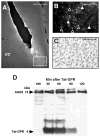Activator of G protein signaling 3: a gatekeeper of cocaine sensitization and drug seeking
- PMID: 15091342
- PMCID: PMC3619420
- DOI: 10.1016/s0896-6273(04)00159-x
Activator of G protein signaling 3: a gatekeeper of cocaine sensitization and drug seeking
Abstract
Chronic cocaine administration reduces G protein signaling efficacy. Here, we report that the expression of AGS3, which binds to GialphaGDP and inhibits GDP dissociation, was upregulated in the prefrontal cortex (PFC) during late withdrawal from repeated cocaine administration. Increased AGS3 was mimicked in the PFC of drug-naive rats by microinjecting a peptide containing the Gialpha binding domain (GPR) of AGS3 fused to the cell permeability domain of HIV-Tat. Infusion of Tat-GPR mimicked the phenotype of chronic cocaine-treated rats by manifesting sensitized locomotor behavior and drug seeking and by increasing glutamate transmission in nucleus accumbens. By preventing cocaine withdrawal-induced AGS3 expression with antisense oligonucleotides, signaling through Gialpha was normalized, and both cocaine-induced relapse to drug seeking and locomotor sensitization were prevented. When antisense oligonucleotide infusion was discontinued, drug seeking and sensitization were restored. It is proposed that AGS3 gates the expression of cocaine-induced plasticity by regulating G protein signaling in the PFC.
Figures









Comment in
-
Accessories to addiction: G protein regulators play a key role in cocaine seeking and neuroplasticity.Neuron. 2004 Apr 22;42(2):181-3. doi: 10.1016/s0896-6273(04)00223-5. Neuron. 2004. PMID: 15091332 Review.
References
-
- Altschul SF, Boguski MS, Gish W, Wootton JC. Issues in searching molecular sequence databases. Nat Genet. 1994;6:119–129. - PubMed
-
- Anderson SW, Bechara A, Damasio H, Tranel D, Damasio AR. Impairment of social and moral behavior related to early damage in human prefrontal cortex. Nat Neurosci. 1999;2:1032–1037. - PubMed
-
- Baker DA, McFarland K, Lake RW, Shen H, Tang XC, Toda S, Kalivas PW. Neuroadaptations in cystine-glutamate exchange underlie cocaine relapse. Nat Neurosci. 2003;6:743–749. - PubMed
-
- Berke JD, Hyman SE. Addiction, dopamine, and the molecular mechanisms of memory. Neuron. 2000;25:515–532. - PubMed
-
- Bernard ML, Peterson YK, Chung P, Jourdan J, Lanier SM. Selective interaction of AGS3 with G-proteins and the influence of AGS3 on the activation state of G-proteins. J Biol Chem. 2001;276:1585–1593. - PubMed
Publication types
MeSH terms
Substances
Grants and funding
LinkOut - more resources
Full Text Sources
Other Literature Sources
Medical
Molecular Biology Databases
Miscellaneous

